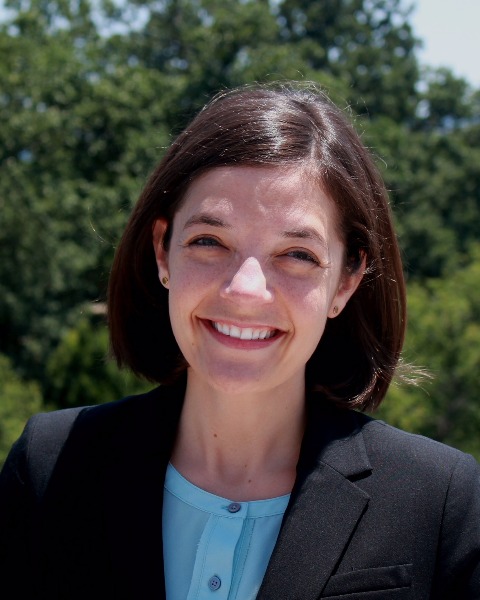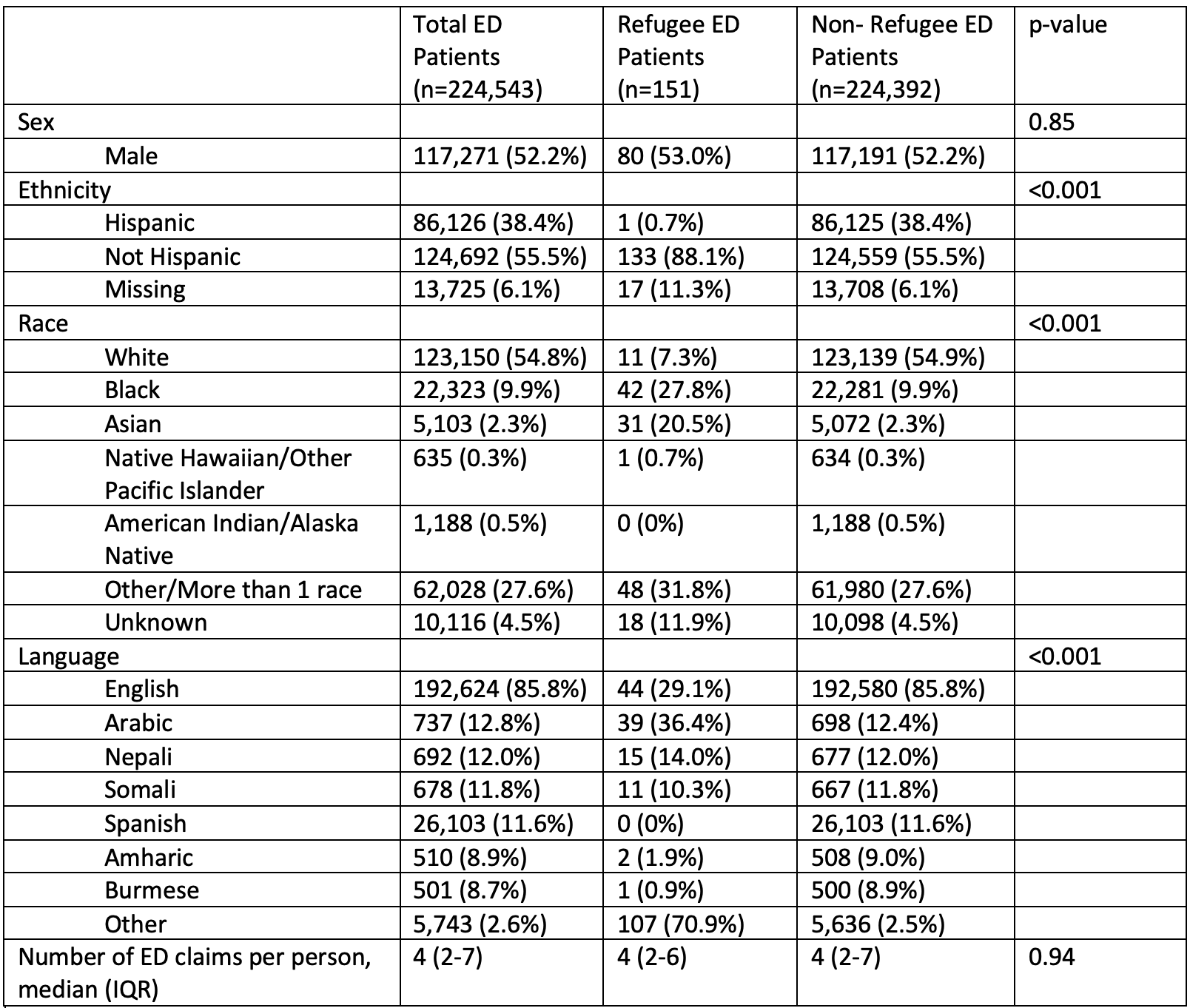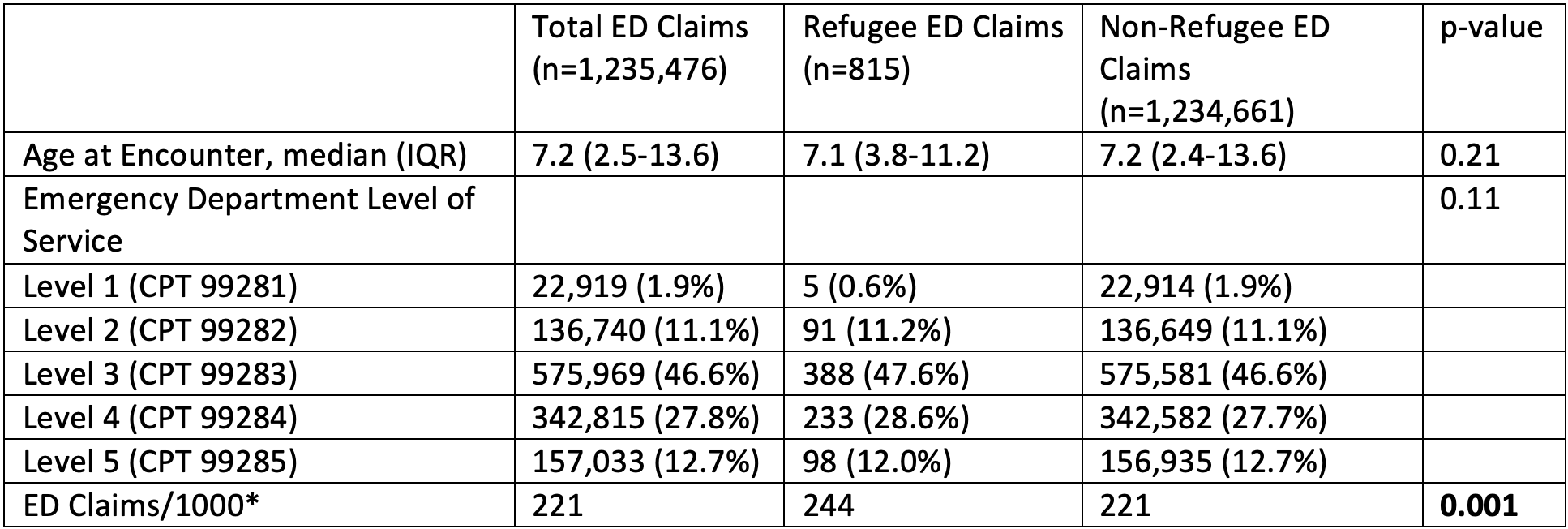Emergency Medicine: All Areas
Category: Abstract Submission
Emergency Medicine XI
398 - Emergency Care Utilization by Refugee Children
Sunday, April 24, 2022
3:30 PM - 6:00 PM US MT
Poster Number: 398
Publication Number: 398.315
Publication Number: 398.315
Anna Abrams, University of Colorado School of Medicine, Denver, CO, United States; Jan Leonard, University of Colorado Anschutz Medical Campus, Aurora, CO, United States; Sarah E. Brewer, University of Colorado School of Medicine, Aurora, CO, United States; Janine Young, Denver Health and Hospitals, Denver, CO, United States; Kathleen Adelgais, University of Colorado School of Medicine, Aurora, CO, United States

Anna Abrams, MD (she/her/hers)
Pediatric Emergency medicine Fellow
University of Colorado School of Medicine
Denver, Colorado, United States
Presenting Author(s)
Background: Refugees comprise a growing facet of our population and face certain barriers to accessing healthcare despite provision of short-term transitional services after arrival. Limited access to primary care may lead to increased emergency department (ED) utilization for low acuity visits. Despite known barriers to care, little is known regarding how refugees access emergency care and few studies have focused on the pediatric refugee population.
Objective: To compare the proportion of ED claims and median level of service (LOS) of refugee and non-refugee children in a statewide medical claims database.
Design/Methods: We conducted a retrospective cohort study of patients 0 to 18 years old in the Colorado All Claims Payer Database (CACPD) from 2014-2019. Patients were identified in the CACPD using deterministic linkage of refugee children from a refugee services clinic. Procedure and diagnosis ICD9/10 codes, Healthcare Common Procedure Coding System (HCPCS), and Current Procedural Terminology (CPT) codes were obtained from the CACPD and patient demographics were extracted from a multi-institutional data warehouse. Outcomes of interest were proportion of ED claims as measured by the number of ED claims per 1000 combined ED and outpatient claims, a standard metric of ED utilization, and LOS of ED claims as a measure for ED visit complexity. HCPCS and CPT codes were used to indicate type of claim (ED vs outpatient) and LOS (ED codes 99281-99285; outpatient codes 99201-99205). We compared demographics, frequency of claims by type, and median LOS between the refugee and non-refugee patients using chi-square.
Results: There were 5,590,808 total claims (3,334 refugee; 5,587,474 non-refugee) with 1,235,476 ED claims (815 refugee; 1,234,661 non-refugee). The median age of patients was 7.2 years (IQR 2.5-13.6) and 52% were male. Top races among refugees included Other/Multiracial (31%), Black (28%), and Asian (21%). Proportion of ED claims was higher in the refugee population than the non-refugees (244 vs 221, p=0.001). Median LOS for ED claims was the same for refugees and non-refugees with Level 3 (99283) being the most common (47%). Median number of ED claims per individual patient was the same between groups (Table 1).Conclusion(s): Proportion of ED claims was higher in the refugee population with no differences in Level of Service in a statewide claims database. Further study is needed to determine if healthcare disparities account for this difference in utilization and if certain services may be necessary to support the care of the refugee children.
Table 1. Demographics of Study Population
Table 2. Emergency Department (ED) Claims and Level of Service * ED claims per 1000 total ED and outpatient claims
* ED claims per 1000 total ED and outpatient claims
Objective: To compare the proportion of ED claims and median level of service (LOS) of refugee and non-refugee children in a statewide medical claims database.
Design/Methods: We conducted a retrospective cohort study of patients 0 to 18 years old in the Colorado All Claims Payer Database (CACPD) from 2014-2019. Patients were identified in the CACPD using deterministic linkage of refugee children from a refugee services clinic. Procedure and diagnosis ICD9/10 codes, Healthcare Common Procedure Coding System (HCPCS), and Current Procedural Terminology (CPT) codes were obtained from the CACPD and patient demographics were extracted from a multi-institutional data warehouse. Outcomes of interest were proportion of ED claims as measured by the number of ED claims per 1000 combined ED and outpatient claims, a standard metric of ED utilization, and LOS of ED claims as a measure for ED visit complexity. HCPCS and CPT codes were used to indicate type of claim (ED vs outpatient) and LOS (ED codes 99281-99285; outpatient codes 99201-99205). We compared demographics, frequency of claims by type, and median LOS between the refugee and non-refugee patients using chi-square.
Results: There were 5,590,808 total claims (3,334 refugee; 5,587,474 non-refugee) with 1,235,476 ED claims (815 refugee; 1,234,661 non-refugee). The median age of patients was 7.2 years (IQR 2.5-13.6) and 52% were male. Top races among refugees included Other/Multiracial (31%), Black (28%), and Asian (21%). Proportion of ED claims was higher in the refugee population than the non-refugees (244 vs 221, p=0.001). Median LOS for ED claims was the same for refugees and non-refugees with Level 3 (99283) being the most common (47%). Median number of ED claims per individual patient was the same between groups (Table 1).Conclusion(s): Proportion of ED claims was higher in the refugee population with no differences in Level of Service in a statewide claims database. Further study is needed to determine if healthcare disparities account for this difference in utilization and if certain services may be necessary to support the care of the refugee children.
Table 1. Demographics of Study Population

Table 2. Emergency Department (ED) Claims and Level of Service
 * ED claims per 1000 total ED and outpatient claims
* ED claims per 1000 total ED and outpatient claims